The legend of Eduardo “Lalo” Angeles is growing quickly. His mezcals have been highly sought after in Oaxaca for many years and his personal brand, Lalocura, is quickly becoming one of the more well-acclaimed mezcals available on the international market. I’m not sure when Tyler and I first heard of Lalo. His name came up when visiting other producers in Lalo’s town of Santa Catarina Minas. We’d seen his name on some amazing older bottles from other brands. I also recall a few years ago at Mezcaloteca in Oaxaca City, asking a bartender who their favorite producer was. “There’s this guy named Lalo in Minas,” she’d told me. “He’s a living legend.”
We’d managed to score several of his bottles at Mercado Benito Juárez and few other places in Oaxaca City over the years. Some were older bottles from the brand Sacalabras, who bottled some of Lalo’s creations before Lalo started his own Lalocura brand. Other bottles were even older from other brands in Santa Catarina Minas. We tried to visit him last year, but our timing didn’t work out.
Arriving in Santa Catarina Minas
We rolled into the small town of Santa Catarina Minas in the late afternoon. It’d been a long and incredible day thus far, visiting several other palenques and artisans with Omar Alonso, who is better known as Oaxacking on Instagram and elsewhere online. You can read about our adventures from earlier that day in our previous blog post A Tour with Oaxacking: Mezcal Ilegal, Convite, Pulque, and More
Omar drove up to the palenque and parked in the grass next to a building that had a massive mural of the Lalocura label. We jumped out, walked down past the pit ovens, stacked cooked agave, and into the area where Lalo and his team mash the cooked agave by hand with mallets. There were a few younger employees working on a couple small clay pot stills that were mid-distillation, but there was no initial sign of Lalo.
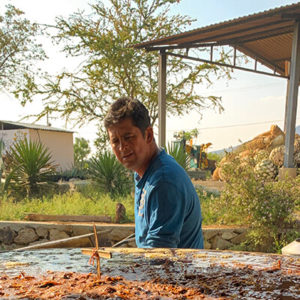
Maestro Mezcalero Eduardo “Lalo” Angeles
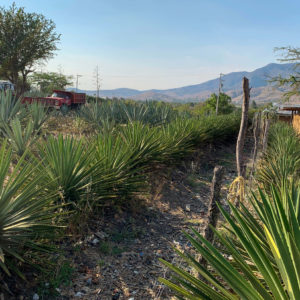
A field of agave at Lalo Angeles’ palenque in Santa Catarina Minas
We loitered around the palenque for five or ten minutes, trying our best to stay out of the way. Then, suddenly, Lalo appeared up the hill, walking down toward the palenque with the sun setting bright and fiery behind him. Even from afar, he had a presence about him that is tough to put into words: generations of knowledge and integrity blended with a certainty of the future and progress. It was like seeing Willie Nelson or Snoop Dogg or some other living legend for the first time. He walked directly over to the wooden fermentation tanks and began stirring and testing with a long bamboo shoot. Omar introduced us and Lalo quickly walked us through the palenque before leading us up to his outdoor kitchen and dining area, where there was a table full of amazing food. Omar warned us; “make sure you eat, you’re about to taste a lot of mezcal.”
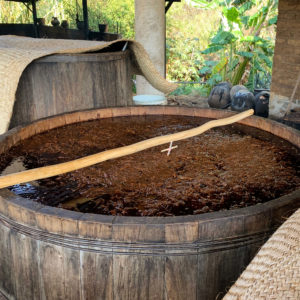
Crushed agave fermenting with open air yeasts
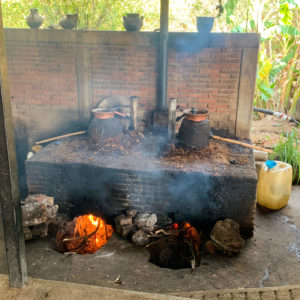
Lalo distills all his mezcal in small clay pots
The House of 1,000 Mezcals
After dinner, we moved from the outdoor kitchen into Lalo’s home. The entire home is constructed of bricks that are made from finished bagaso (the cooked and distilled agave fibers that are pulled out of the still). Many other buildings on his property are also made of the bagaso fibers. Walking into Lalo’s home is an experience. To left of his entryway are massive containers of un-blended puntas, hearts, and colas. He told us later that he prefers to blend his distillation cuts in the morning before he brushes his teeth. This timing gives him the best results as the taste buds are hyper-alert and not altered by anything he may have eaten.
To right of the doorway, there’s a living room with a table full of Lalocura bottles of various sizes. The living room and all down the long hallway to the bathroom are lined with dozens of five gallon glass jugs of mezcal. Given the bagaso bricks and all the mezcal resting in glass, it’s safe to say that Lalo spends most of his days completely surrounded by agave.
We sat down at a dining table in the main room. Lalo set up sixteen small glasses in front of each of us. We’d be tasting a series of mezcals, he explained, and he wanted us to spend a good amount of time focusing on each one.
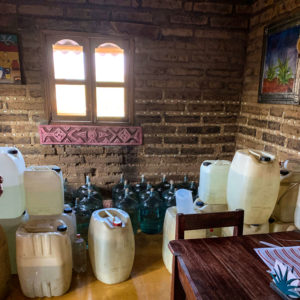
Un-blended distillation cuts of various batches
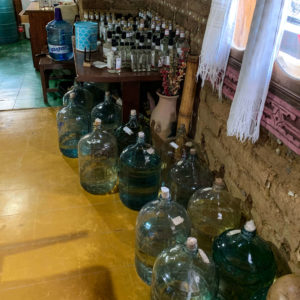
Some bottles that are ready for sale with other mezcal resting
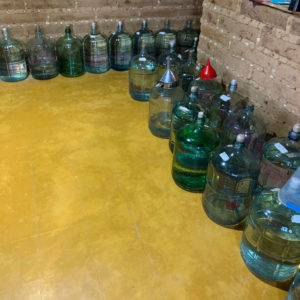
More mezcal in the main living room
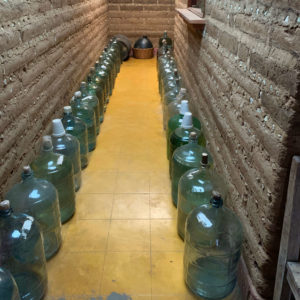
More mezcal in the hallway. Notice the bricks made of spent bagaso
A History of Lalocura
“What do you know about mezcal?” Lalo asked after the table was set. The question caught me off guard, but it was really a setup for Lalo to tell us about his personal history with the spirit. He recounted moments of his youth, working alongside his father, the legendary Don Lorenzo Angeles. He spoke about his experiences producing for another brand, which is run by other members of his family in Santa Catarina Minas (the name of which he explicitly asked us not to mention in this blog). He spoke of working with Sacalabras and building his home, palenque, and other buildings on his property by hand with (mostly) spent agave fibers. While the Lalocura brand was created in 2014, it’s something that Lalo has been working on for the last fourteen years.
Lalo Laws
Before he poured a single mezcal, Lalo recited his mezcal doctrine, which was made up of several rules for mezcal production and consumption. Here are the Lalo Laws (which he repeated to us again after the tasting):
- Mezcal must be at least 45% ABV
- The batch must be less than 2,000 liters
- The label must list the Mezcalero’s name
- The label must list the type of oven used to cook the agave (must be an underground pit oven)
- Don’t age Mezcal. Mezcal is meant to be consumed
- Always smell the agave with your hands and look for the perlas
- Always follow producers, not brands
- Never trust anything you read on the label of a bottle (unless, of course, it’s a bottle of Lalocura)
Tasting Lalocura
Lalo structured the tasting in such a way that we’d taste two individual varietals, and then an Ensamble (which he calls blends) of the two agaves. For example, the first mezcal we tasted was made with agave Espadin. The second mezcal was made with agave Tobaziche. And the third mezcal was made with agave Espadin and agave Tobaizhe. This was an interesting process as you really can familiarize yourself with the different characteristics of each agave before tasting them in a mixed context. The groupings of agave were ordered by level of complexity with the final pour consisting of high ABV Barril (San Martinero) Puntas.
For each pour, Lalo would pull a small amount of mezcal into a bamboo shoot, releasing the mezcal into a gourd to show us the perlas (bubbles), as sign of quality, for each one. Once we’d observed the perlas, he would pull the mezcal back into the bamboo shoot and then release a good amount into our hands. We’d rub our hands together and smell the rich agave scents while he described each mezcal in great detail. Only after seeing the perlas and rubbing mezcal into our palms did we taste the mezcal. This proceeded for all sixteen mezcals! It was a great way to really take time to focus on each individual spirit.
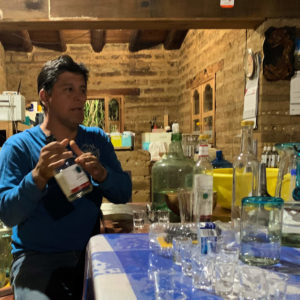
Lalo explaining the importance of labeling and what should always be included (see Lalo Laws above)
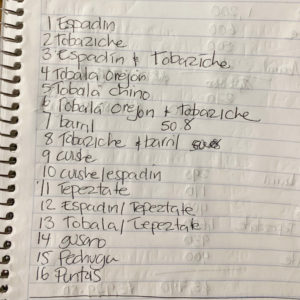
The list of mezcal poured for the formal tasting
Special Bottles
While all of the mezcal we tasted was amazing, there were a few that really stood out to us. The fourth and fifth mezcals that we tasted were both made with agave Tobala, however Lalo differentiates between Tobala grown in the shade and Tobala grown in the sun. The shade-grown Tobala, known as Orejon, is more common than sun-grown Tobala, which is known as Chino. For me, the Tobala Orejon was much more mellow and earthy, while the Tobala Chino was bright and full of citrus.
Another standout comparison was the third mezcal, which was made with Espadin and Tobaziche, compared to the fourteenth mezcal, which was also made with Espadin and Tobaziche, but with the addition of a worm. Given that the mezcal worm is mostly associated with lower quality mezcal in the US, we were shocked to learn that Lalo had a mezcal with a worm in it. He explained that if the worm was floating, it was good. If the worm was at the bottom of the bottle, it was bad. After tasting them both side by side, I can confidently report that the mezcal con gusano definitely tasted like worms, while the mezcal sin gusano did not. The worm made a huge difference.
After the formal, structured tasting of sixteen mezcals, Lalo poured from a recent batch of Jabali. This was the first time he’d ever produced Jabali, he explained. Agave Jabali is not common in Minas. He triple-distilled this Jabali and it took 300 kilos of the raw agave to produce just a single liter of mezcal. It was rich but not quite as audacious as other Jabali on the market. It was still very good though.
Lalo also explained that whenever he has a small amount mezcal remaining after bottling, he’ll place it into an old clay jug to mix with the leftovers of other batches. The clay jug has been in his family since 1923, and it imparts a faint old and dusty character on the mezcal inside. It was impossible to tell how many different batches were in the blend. It tasted good, but we couldn’t distinguish individual flavors or agave.
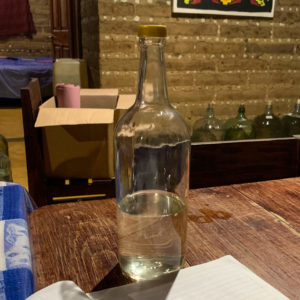
Lalo’s first and only litre of Jabali
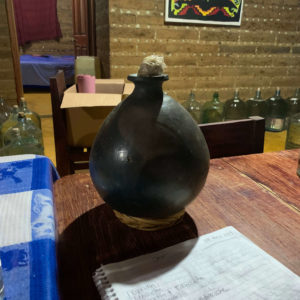
A clay jug used for holding mezcal in Lalo’s family since 1923
Leaving Minas
After over four hours at Lalo’s, we purchased as much mezcal as we could carry, and said goodbye. Omar jumped behind the wheel and we poured ourselves into his SUV. We made one last stop in Minas, for a late night snack and coffee, before heading back to Oaxaca City. It’d been an incredible day with Omar and an amazing ending of the day with Lalo.
If you’re headed to Oaxaca and looking to experience the culture, food, and art (including mezcal) that make it such an amazing place, Omar is a great choice. The whole day felt less like a tour and more like we were driving around visiting all of his friends, who were all incredibly welcoming and passionate about what they do. Omar has been featured in many publications, like Vice and USA Today, and we can report that he exceeds all expectations. You can follow him on his Oaxacking Instagram and book tours on Oaxacking.com.


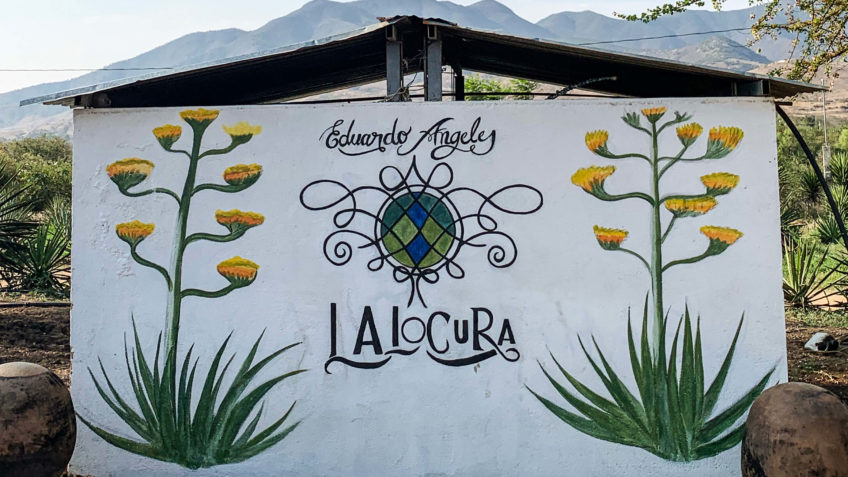

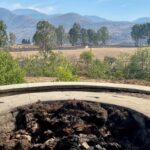
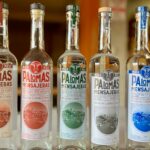
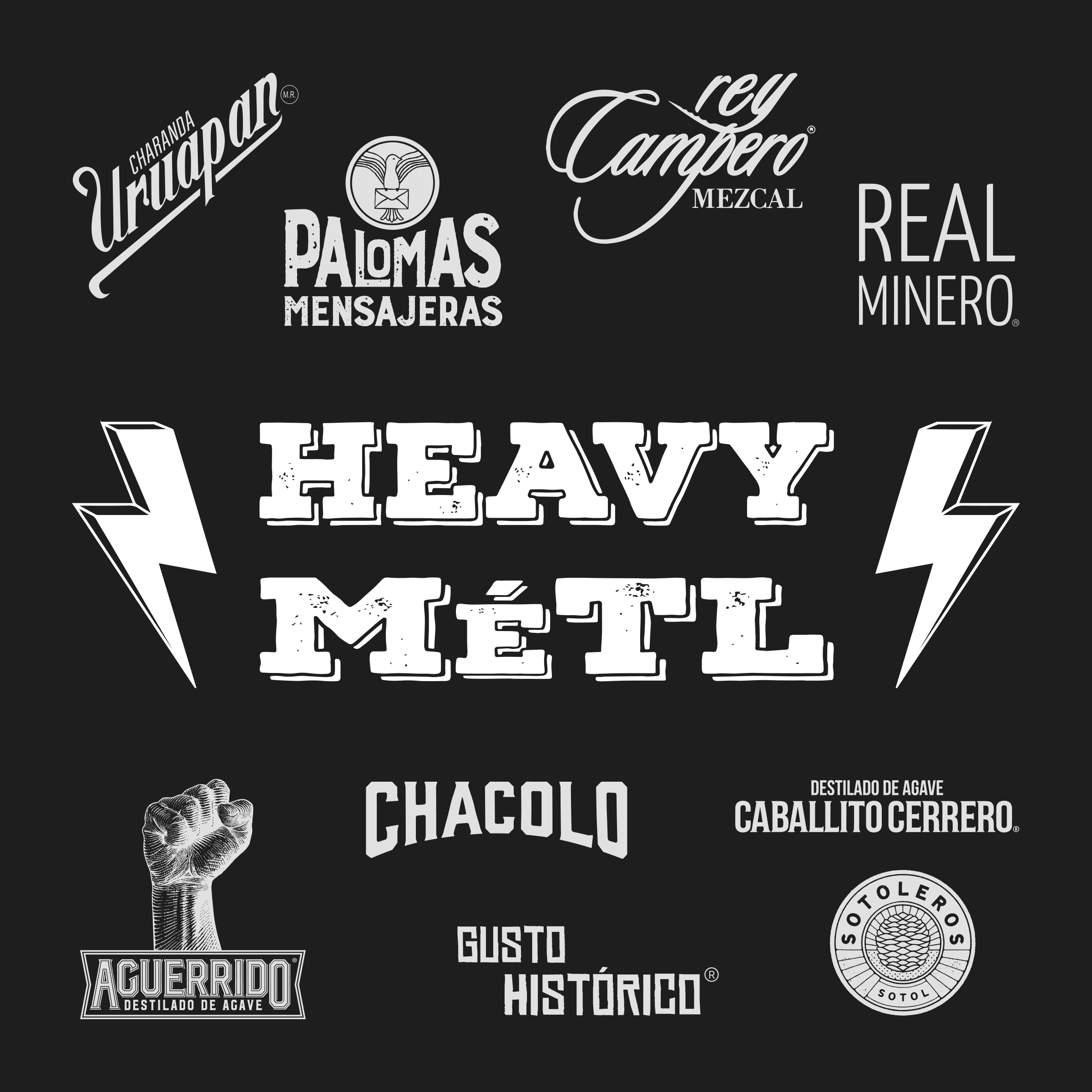
William Boyd
8 months agoSlipping right now the Lalocura chino-Tobasich “blend.” “Wow, can mezcal be any better than this?”–my first few thoughts. [Our family tour was on November 4, 2023.]
Chris
5 years agoI went to see Lalo in May of 2019 on the way back from a couple of nights in San Jose del Pacifico and did much of what you did at his house. What a treat! I love the sign on the way into Minas, “La Cuna de mezcal” (The cradle). He seemed a little surprised that we just showed up without any guide. We were going to visit another palenque in town, but there were closed for a fiesta. Hit or miss that way, which is fine with me. We went back another day and they were open, but it had more of an industrial feel to it, whereas Lalo was very personal. A couple of asides if you go: There is a a woman who dresses like Frida Kahlo in the Ocotlan mercado on the way and she serves up some great food at her Frida stall in the food area about 2/3 of the way back. Also for those into into art, the alebriges, hand painted wooden sculptures, at Jose and Maria Angeles, studio in Tilcajete are the finest I have seen. He also has a store on the Andador near Santo Domingo in Oaxaca and a restaurant with a gift shop where you turn off the highway into Tilcajete, but it’s worth a detour off the Mezcal trail to see how it’s done. Museum quality Zapotec art.
Vania Vegett
5 years agoWow, that’s been interesting. And Minas is a really place to be!
Keep it up, guys!
Gloria Davalos
2 years agoWe went to visit Lalo’s mezcal distillery in February 2022 and tasted some of the finest mezcal in Oaxaca. Thanks to Omar we were able to do this. I totally recommend you have Omar give you a tour of Oaxaca. He knows the best places to visit.
Nick
5 years agoSeconding Rakhal and Rsidrys’s comments. Thanks for the update. Managed to get a taste of Lalocura Pechuga recently and it put Lalocura on the list for a visit in September.
Rakhal
5 years agoGreat article! It sounds like an epic tasting! I plan to visit his Palenque in December, this article makes me want to drop everything and head there now!! Following the Mezcalero is great advice, I’ve been wanting to make some trips to search out far flung Palenques of my favorite Mezcaleros. It sounds like Omar would be a great person to help me make that happen.
Clint Bell
5 years agoGreat story. Awesome job guys. Will use Alonso in February 2020. Have visited many a Palenque but not Lalocura. Will be going there for sure. Have you been to Mezcal Vago, Mezcalero Aquilino Garcia. He is epic.
rsidrys
5 years agoAwesome, awesome, awesome!
I learned a lot from this. You guys did a good job picking his brain and documenting the experience. Thank you!
I really like his rule: Always follow producers, not brands.
DavidB
5 years agoSuch an emotional and transcendent experience visiting with Maestro Eduardo. Complexity, care, patience, precision, pride, respect, gratitude. His artistry is an archetype of Oaxacan culture. So grateful for the opportunity to share, celebrate, relive, enjoy with great pleasure, and pass on the experience with others. Need to go back soon!